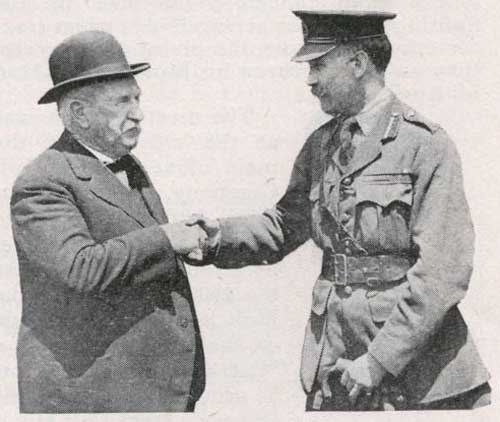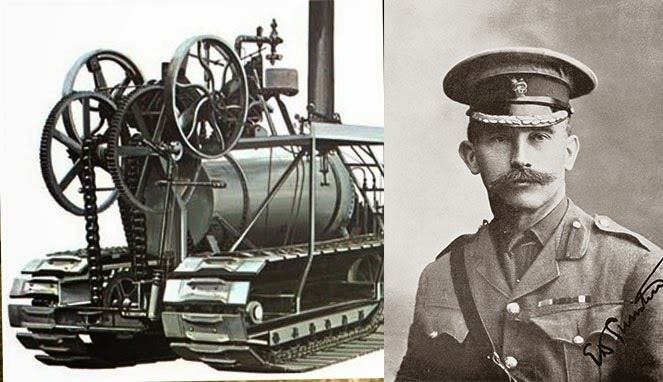Allegiance United Kingdom Years of service 1888–1919 Role Developer | Name Ernest Swinton | |
 | ||
Born 21 October 1868Bangalore, India ( 1868-10-21 ) Battles/wars Second Boer WarFirst World War Other work Air Ministry, Citroen, Chichele Professor of Military History at Oxford University, Colonel Commandant of the Royal Tank Corps Died January 15, 1951, Oxford, United Kingdom Books The Defence of Duffer\'s Drift Similar People Aleksey Kuropatkin, James Lennox Dawson, Reg Varney, Thomas Frank Durrant, James Dundas | ||
SKKK Arif Margono, Malang // Ernest Swinton class // Elisha Otis class // 2016-2017
Major-General Sir Ernest Dunlop Swinton, KBE, CB, DSO (21 October 1868 – 15 January 1951) was a British Army officer who was active in the development and adoption of the tank during the First World War. He was also a war correspondent and author of several allegorical works of fiction on military themes, including a lastingly influential book on tactics and good practice. He is credited with having coined the word "tank" as a code-name for the first tracked, armoured fighting vehicles.
Contents
- SKKK Arif Margono Malang Ernest Swinton class Elisha Otis class 2016 2017
- Early life and career
- First World War
- Development of tanks
- Post war
- Family life
- Honours and awards
- References

Early life and career

Swinton was born in Bangalore, India, in 1868. His father worked for the Madras Civil Service. Swinton was educated at University College School, Rugby School, Cheltenham College, Blackheath Proprietary School, and the Royal Military Academy, Woolwich. He became an officer in the Corps of Royal Engineers in 1888, serving in India and becoming Lieutenant in 1891.

He served as a Captain during the Second Boer War (1899–1901), and received the Distinguished Service Order (DSO) in November 1900. Although principally concerned with railway construction, he took a keen interest in tactics, fortifications, and the effectiveness of modern weaponry, especially the recently introduced machine-gun. After the war, he wrote his book on small unit tactics, The Defence of Duffer's Drift, a military classic on minor tactics that has been used by the Canadian and British Armies to train their NCOs and officers and US military to train its officers. In the years leading up to the First World War, he served as a staff officer and as an official historian of the Russo-Japanese War.
First World War

The War Minister, Lord Kitchener, appointed Swinton as the official British war correspondent on the Western Front. Journalists were not allowed at the front, and Swinton's reports were censored, leading to an effectively uncontroversial although even-handed reporting.
Development of tanks
Swinton recounts in his book Eyewitness how he first got the sudden idea to build a tank on 19 October 1914, while driving a car in France. It is known that in July 1914 he received a letter from a friend, a mining engineer named Hugh F. Marriott whom he had met while in South Africa. Marriott occasionally sent Swinton news of technical developments that might have a military application, and his letter described a machine he had seen in Antwerp, an American-made Holt Caterpillar Tractor. He suggested that the machine might be useful for transport, and Swinton passed the information on to several military and political figures he thought it might interest. At the time, with no apparent prospect of war, the idea seemed to be a matter only of transport efficiency, and Swinton forgot about the matter. The idea of a caterpillar track as the basis for a fighting vehicle occurred to him only as he drove from St. Omer to Calais on the morning of 19 October.

In Britain, David Roberts of Richard Hornsby & Sons had attempted starting in 1911 to interest British military officials in a tracked vehicle, but failed. Benjamin Holt of the Holt Manufacturing Company bought the patents related to the "chain track" track-type tractor from Richard Hornsby & Sons in 1914 for £4,000. When World War I broke out, with the problem of trench warfare and the difficulty of transporting supplies to the front, the pulling power of crawling-type tractors drew the attention of the military.
The British War Office conducted trials with Holt tractors at Aldershot but saw them only as suitable for towing heavy artillery. Major Swinton was sent to France as an army war correspondent. In November 1914 he suggested to Sir Maurice Hankey, Secretary of the Committee of Imperial Defence, the construction of a bullet-proof, tracked vehicle that could destroy enemy machine guns.
In 1916 Swinton was promoted to Lieutenant Colonel and given responsibility for training the first tank units. He created the first tactical instructions for armoured warfare. The Royal Commission on Awards to Inventors decided after the war that the inventors of the tank were Sir William Tritton, managing director of Fosters and Major Walter Gordon Wilson. By 1918, the War Office had received 2,100 Holt tractors.
In April 1918, while on a tour of the US, Swinton visited Stockton, California to publicly honour Benjamin Holt and the company for their contribution to the war effort and to relay Britain's gratitude to the inventor. Benjamin Holt was recognised by the General at a public meeting held in Stockton.
Post-war
In 1919 Swinton retired as a Major General. He subsequently served in the Civil Aviation department at the Air Ministry. He thereafter joined Citroën in 1922 as a director. He was Chichele Professor of Military History at Oxford University and a Fellow of All Souls College, Oxford from 1925 to 1939; he was also Colonel Commandant of the Royal Tank Corps from 1934 to 1938. In 1938, he edited Twenty Years After: the Battlefields of 1914–18: then and Now a publication of George Newnes Limited which was planned for issue in 20 parts and which ultimately amounted to 42. The magazine-style publication contained wartime and present-day (ca. 1938) images of France.
Family life
Swinton married Grace Louise Clayton in 1897 and they had two sons and a daughter. His daughter died in a road accident during the Second World War. Swinton died in Oxford on 15 January 1951.
